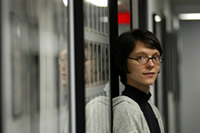|
|
Vol.
29 No. 2
March-April 2007
From
the Editor
 Treat yourself and read A Whole New Mind* by Daniel Pink. Add here and there the “chem” word that applies best, such as chemists, chemistry, or chemical, and the book provides the basic ideas and arguments that should allow chemists to successfully transition from the Information Age to the Conceptual Age. Treat yourself and read A Whole New Mind* by Daniel Pink. Add here and there the “chem” word that applies best, such as chemists, chemistry, or chemical, and the book provides the basic ideas and arguments that should allow chemists to successfully transition from the Information Age to the Conceptual Age.
As Pink puts it, the Information Age featured an economy and society built on logical, linear, computer-like capabilities, while the Conceptual Age that is rising in its place is built on inventive, empathic, and big-picture capabilities. Throughout his book, Pink uses the simplified analogy of how our brain functions: our left hemisphere is the more logical, sequential, and rational, while the right is more simultaneous and context driven. Pink argues that the era of “left brain” dominance, and the Information Age that it engendered, are giving way to a new world in which “right brain” qualities of inventiveness, empathy, and meaning predominate. This evolution into the Conceptual Age will force everyone to reconsider what they do and how.
So, what does that mean for scientists and chemists? If Pink is right and the future belongs to creators and meaning makers, then the future belongs to chemists indeed. While (most) chemists are logical and analytical, their playground is such that they have to be very inventive as well. Chemists belong in the same category as artists, inventors, designers, storytellers, caregivers, and big-pictures thinkers.
While orbiting around the world of IUPAC, I can think of one particular committee that fits this very portrait of chemists working in a Conceptual Age: CHEMRAWN, the committee on “CHEMical Research Applied to World Needs.” Contrary to other groups, CHEMRAWN projects do not share a commonality in term of chemistry discipline and specialty, but instead are goal oriented. The objective of CHEMRAWN is to foster new ideas to provide solutions to real problems. On page 4, John Malin, current chairman of CHEMRAWN, presents a short history and an example of what CHEMRAWN can be and can do. From world food supplies to sustainable agriculture, from sources of organic raw materials to greenhouse gases, from innovation in chemical industry to education, these are the sorts of topics CHEMRAWN has explored or is exploring.
There are challenges for every chemist, and in line with Pink’s argument, the challenges of the Conceptual Age might very well afford rich rewards for those involved in finding solutions.
Fabienne
Meyers
[email protected]
www.iupac.org/publications/ci
*A Whole New Mind—Moving from the Information Age to the Conceptual Age, Daniel H. Pink, 2005, Riverhead Books, New York, 2005.
Page
last modified 9 April 2007.
Copyright © 2003-2007 International Union of Pure and
Applied Chemistry.
Questions regarding the website, please contact [email protected]
|